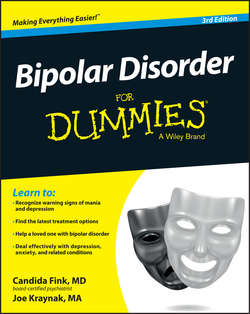Читать книгу Bipolar Disorder For Dummies - Joe Kraynak - Страница 4
На сайте Литреса книга снята с продажи.
Part I
Getting Started on Your Bipolar Journey
Chapter 1
Grasping Bipolar Disorder: Symptoms and Diagnosis
ОглавлениеIn This Chapter
▶ Meeting the manual used to diagnose bipolar disorder
▶ Recognizing the two poles of bipolar: mania and depression
▶ Telling the difference between bipolar I, bipolar II, and other types
▶ Augmenting the diagnosis with specifiers and distinguishing it from other conditions
▶ Diagnosing bipolar in children … or not
When you initially encounter bipolar disorder, one of the first questions you’re likely to ask is, “What is it?” The short answer is this: Bipolar disorder is a medical illness characterized by alternating periods of abnormally elevated and depressed mood. The second question that most people ask is, “Can I get tested for it?” And the short answer is no. Doctors arrive at a diagnosis by conducting a physical and mental status examination; taking a close look at a person’s symptoms, medical history, and family history; and ruling out other possible causes. For guidance, doctors use a book called the Diagnostic and Statistical Manual of Mental Disorders (DSM), which presents the diagnostic criteria for determining whether a person is likely to have bipolar disorder.
This chapter digs deep into the DSM to reveal what bipolar disorder is and isn’t. It describes what elevated and depressed moods look like and provides you with the details you need to tell the difference between the various bipolar diagnoses, including bipolar I, bipolar II, and a form of bipolar called rapid-cycling. We discuss diagnostic specifiers that enable doctors to more precisely describe a person’s symptoms and inform his treatment decisions. We distinguish bipolar disorder from conditions that may have similar symptoms and discuss other conditions that commonly accompany bipolar disorder, such as alcoholism and substance use disorder. We wrap up with a discussion of the challenges of diagnosing bipolar in children and young adults.
